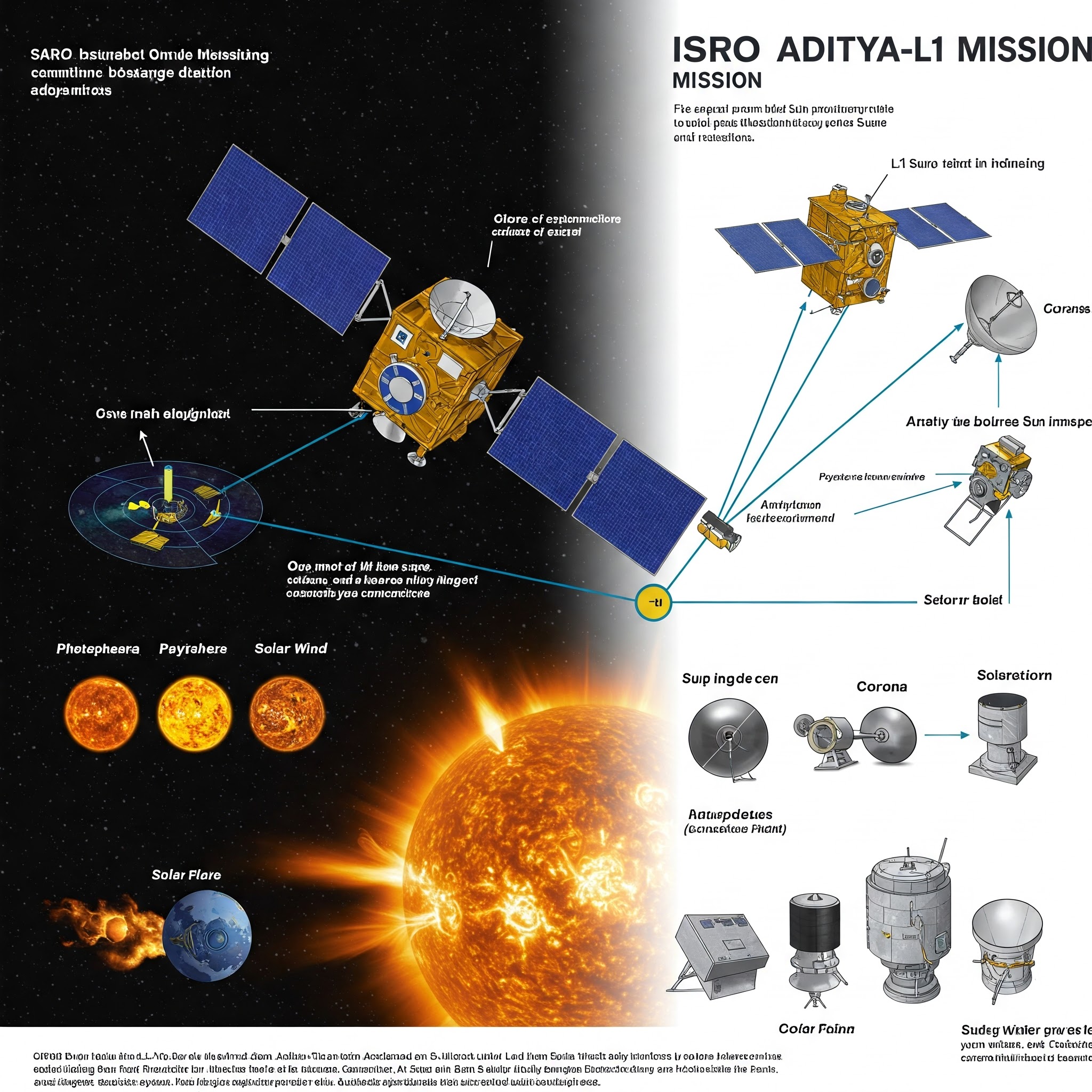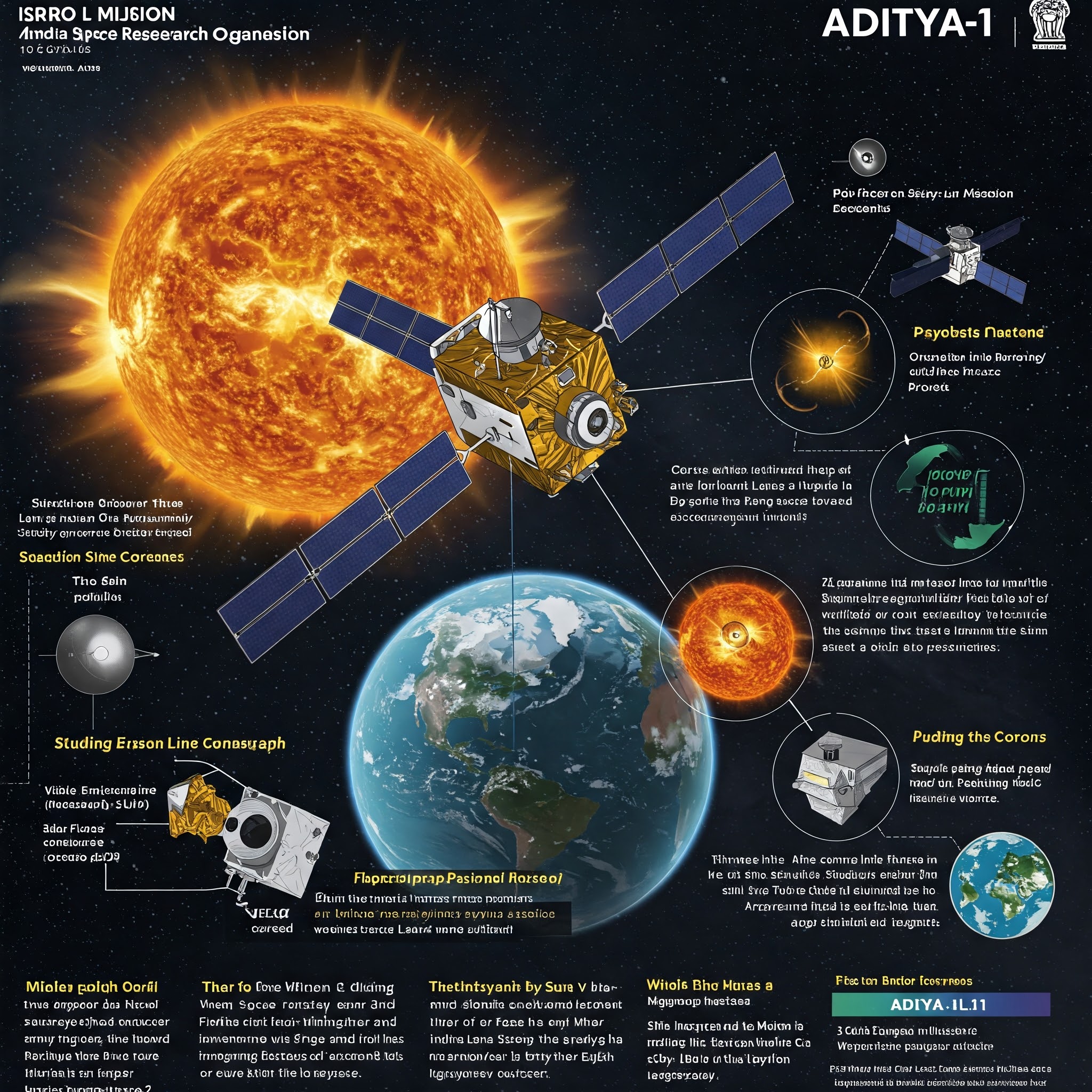ISRO Aditya L1 Mission Explained: India’s First Solar Mission in Simple Words
🔭 What is Aditya L1 Mission ISRO Aditya L1 mission explained?

Aditya L1 is India’s first dedicated solar mission launched by the Indian Space Research Organisation (ISRO). Its main goal is to study the Sun, especially the outer layers like the corona and solar wind, which impact space weather and satellite communication on Earth.
Launched on September 2, 2023, this mission marks a major leap in India’s space science journey.
☀️ ISRO Aditya L1 mission explained Why is Studying the Sun Important?

You might wonder — why study the Sun when it’s always there?
These violent solar activities can:
- Disrupt GPS and satellite signals
- Affect power grids
- Harm astronauts in space
Aditya L1 will help scientists predict space weather events in advance, giving Earth better protection.
🛰️ ISRO Aditya L1 mission explained Where is Aditya L1 Going?
🔬 ISRO Aditya L1 mission explained What Will Aditya L1 Study?
The spacecraft carries 7 advanced instruments (payloads). These tools will:
- Study the Sun’s corona (outer atmosphere)
- Monitor solar flares and radiation
- Measure solar wind speed and magnetic fields
Some key instruments include:
-
VELC (Visible Emission Line Coronagraph) – studies the coron
- ASPEX & PAPA – analyze solar wind particles
🚀 Quick Facts about Aditya L1 ISRO Aditya L1 mission explained
| Feature | Details |
| Launch Date | September 2, 2023 |
| Launch Vehicle | PSLV-C57 |
| Target | Lagrange Point 1 (L1) |
| Mission Duration | ~5 years |
| Orbit Type | Halo Orbit around L1 |
| Total Payloads | 7 scientific instruments |
🇮🇳 Why is Aditya L1 Special for India ISRO Aditya L1 mission explained
. After the success of Chandrayaan and Mangalyaan, Aditya L1 shows that ISRO is now targeting deep space science, not just planetary missions.
📈 ISRO Aditya L1 mission explained What’s Next for Aditya L1?
As of 2025, Aditya L1 has already reached its destination at L1 and started sending valuable data back to Earth. Scientists are now analyzing this data to better understand solar storms and their effects on Earth.
Future findings from Aditya L1 are expected to:
- Help in space weather forecasting
- Improve satellite safety
- Deepen our understanding of the Sun-Earth connection
ISRO Aditya L1 mission explained What is India’s first solar mission Aditya-L1?
Aditya-L1 is India’s inaugural solar mission, launched by the Indian Space Research Organisation (ISRO) on September 2, 2023. This mission aims to study the Sun’s outer layers, particularly the corona, to enhance our understanding of solar activities and their impact on space weather.
🌞 ISRO Aditya L1 mission explained Key Highlights of Aditya-L1:
- Mission Objective: To observe the solar corona, chromosphere, and solar wind, providing insights into solar flares, coronal mass ejections (CMEs), and their effects on Earth’s space environment.
- Orbit and Positioning: The spacecraft is positioned in a halo orbit around the Lagrange Point 1 (L1), approximately 1.5 million kilometers (about 932,000 miles) from Earth. This location allows continuous observation of the Sun without any occultation or eclipses. ISRO+1Wikipedia+1
- Scientific Payloads: Aditya-L1 is equipped with seven instruments designed to study various aspects of the Sun, including:
- VELC (Visible Emission Line Coronagraph): Captures images of the solar corona.
- SoLEXS (Solar Low Energy X-ray Spectrometer) and HEL1OS (High Energy L1 Orbiting X-ray Spectrometer): Monitor solar X-ray emissions.
- Magnetometer: Measures the interplanetary magnetic field. AP News+2Wikipédia, l’encyclopédie libre+2ResearchGate+2ResearchGateVajiram & Ravi+2The Times of India+2AP News+2
- Mission Duration: Planned for approximately five years, allowing for extensive data collection and analysis. Reuters
Aditya-L1 represents a significant milestone in India’s space exploration efforts, contributing valuable data to the global scientific community’s understanding of solar phenomena and space weather forecasting.
What is Aditya-L1 mission ISRO Aditya L1 mission explained answer?
The Aditya-L1 mission is India’s first space-based solar observatory, launched by the Indian Space Research Organisation (ISRO) on September 2, 2023.
✅ Simple Answer:
Aditya-L1 is a scientific space mission launched by ISRO to study the Sun, especially its outer atmosphere (corona) and solar activities like flares and solar wind. It orbits around Lagrange Point 1 (L1), which allows continuous observation of the Sun without Earth’s interference
🔍 Key Facts:
- Launched by: ISRO (India)
- Mission goal: Study the solar corona, solar flares, and space weather.
- Instruments: 7 scientific payloads including telescopes, particle detectors, and magnetometers.
- Mission duration: ~5 years
🧠 Why It Matters:
Understanding the Sun helps protect satellites, power grids, and astronauts from harmful solar activity. Aditya-L1 also strengthens India’s position in space science research.
What is the mission of Aditya-L1 for kids?
The Aditya-L1 mission is India’s first mission to study the Sun, launched by the Indian Space Research Organisation (ISRO) on September 2, 2023. Named after “Aditya,” the Sanskrit word for the Sun, and “L1,” referring to the Lagrange Point 1, this mission aims to observe the Sun from a unique vantage point in space.
🌞 What is Aditya-L1?
Aditya-L1 is a satellite designed to study the Sun’s outer layers, including the corona, chromosphere, and solar wind. It carries seven scientific instruments to observe solar activities and their impact on space weather. The Childrens Post of India
🚀ISRO Aditya L1 mission Where is Aditya-L1 explained Going?
The satellite is traveling to Lagrange Point 1 (L1), a location about 1.5 million kilometers from Earth. This point allows Aditya-L1 to have an uninterrupted view of the Sun, enabling continuous observation without any eclipses or occultations. ISRO
🔍 ISRO Aditya L1 mission explained What Will Aditya-L1 Study?
Aditya-L1’s instruments will focus on:
- Observing solar flares and their impact on space weather.
- Measuring solar wind and magnetic fields.
The Times of India
🧠ISRO Aditya L1 mission Why is Aditya-L1 Important?
By studying the Sun’s behavior, Aditya-L1 will help scientists predict solar storms and understand their effects on Earth. This knowledge is crucial for safeguarding satellites, power grids, and communication networks from solar disruptions. The Times of India
What are the objectives of Aditya-L1 mission Upsc?
✅ ISRO Aditya L1 mission explained Objectives of Aditya-L1 Mission (For UPSC)
It aims to explore the solar corona, solar emissions, and space weather.
The mission’s objectives are crucial for scientific research and technological safety.
🔥 Major Objectives:
- Study the Solar Corona
- Understand how the solar corona is heated to temperatures much higher than the Sun’s surface.
- Investigate coronal mass ejections (CMEs), their origin, and propagation.
- Solar Wind Observations
- Analyze the solar wind and how it affects space weather.
- Study the dynamics and variability of the solar wind.
- Solar Magnetic Field Measurements
- Measure the magnetic fields in the solar corona.
- Understand how solar magnetic storms affect Earth’s magnetosphere.
- Space Weather Monitoring
- Observe and predict solar storms that can impact satellite operations, GPS systems, communication networks, and power grids on Earth.
- Energy Transfer Mechanisms
- Investigate the processes that transport energy from the Sun’s surface to its outer atmosphere.
- Continuous Solar Observation
- Being at Lagrange Point 1 (L1) allows uninterrupted viewing of the Sun without Earth’s shadow interfering, enabling real-time solar monitoring.
✍️ Importance for UPSC:
- Boosts India’s capability in space weather prediction.
- Enhances understanding of Sun-Earth interactions.
- Strengthens India’s position in space science research internationally.
📋 Quick Facts Table for Revision:
| Feature | Details |
| Launched by | ISRO |
| Launch Date | September 2, 2023 |
| Orbit | Halo Orbit around Lagrange Point 1 (L1) |
| Distance from Earth | ~1.5 million kilometers |
| Number of Payloads | 7 scientific instruments |
| Mission Duration | 5 years (planned) |
What is the introduction of first solar?
🌞 ISRO Aditya L1 mission explained Introduction to India’s First Solar Mission: Aditya-L1
Launched by the Indian Space Research Organisation (ISRO) on September 2, 2023, Aditya-L1 marks a major milestone in India’s space exploration journey.
The mission is designed to observe the Sun’s outer atmosphere (corona), solar winds, and solar magnetic fields to better understand their effects on space weather and Earth’s environment.
Aditya-L1 is positioned at the Lagrange Point 1 (L1), about 1.5 million kilometers from Earth, where it enjoys an uninterrupted view of the Sun. Equipped with seven advanced scientific instruments, the mission aims to unlock mysteries about solar storms, coronal heating, and the impact of solar activities on satellite communications and technological infrastructure.
The name “Aditya” means “Sun” in Sanskrit, perfectly representing the mission’s primary focus. With this mission, India joins an elite group of nations like the USA and European countries that are advancing solar research.
What are the benefits of Aditya-L1 mission?
✅ ISRO Aditya L1 mission explained Benefits of Aditya-L1 Mission
1. 🌞 Better Understanding of the Sun
- Helps scientists study the solar corona, solar flares, and coronal mass ejections (CMEs).
2. ⚡ Improved Space Weather Forecasting
- Aditya-L1 helps in predicting solar storms in advance, protecting technology on Earth and in space.
3. 🛰️ Safety for Satellites and Astronauts
- Space weather monitoring helps prevent satellite damage and enhances the safety of future human space missions.
4. 🔬 Scientific Advancement
- Supports international collaboration in the field of heliophysics.
5. 🇮🇳 Boost to India’s Space Science
- Strengthens India’s position in space-based scientific research and innovation.
6. 🧠 Inspiration and Education
- Sparks public interest and student curiosity in astronomy, space science, and STEM education.
📌 Summary Table
| Benefit | Impact |
| Study of solar phenomena | Better understanding of Sun’s behavior |
| Space weather prediction | Protection of satellites and power grids |
| Advancement in science | Boosts solar physics research |
| Technological safety | Helps safeguard electronic systems |
| National pride | Positions India as a space science leader |
🌍☀️ ISRO Aditya L1 mission explained What is the L1 Point in the Solar System?
small object like a satellite.
✅ ISRO Aditya L1 mission explained Simple Explanation:
- A spacecraft placed at L1 stays in a stable position between Earth and the Sun and can observe the Sun continuously without being blocked by Earth.
📌 ISRO Aditya L1 mission explained Why is L1 important?
- Ideal location for solar observation missions like ISRO’s Aditya-L1, NASA’s SOHO, etc.
- Provides uninterrupted views of the Sun for early warning of solar storms and space weather.
🧠 ISRO Aditya L1 mission explained Fun Fact:
There are five Lagrange Points (L1 to L5) in the Earth-Sun system, but L1 is the most useful for solar observation.
